What is Dropshotting for Perch (and why do it?)
Dropshotting for Perch is a clever finesse method of fishing soft plastic lures. It was originally designed for difficult largemouth bass from high-pressure waters in Japan. The rig allows you a huge degree of control over your lure in terms of action, pace and fishing-depth. The key advantage is it lets you suspend your (sinking) lure at any position in the water-column – even when fished in a static presentation. This can unlock fish that have “got wise” to (or are feeling too lazy to chase) jigs.
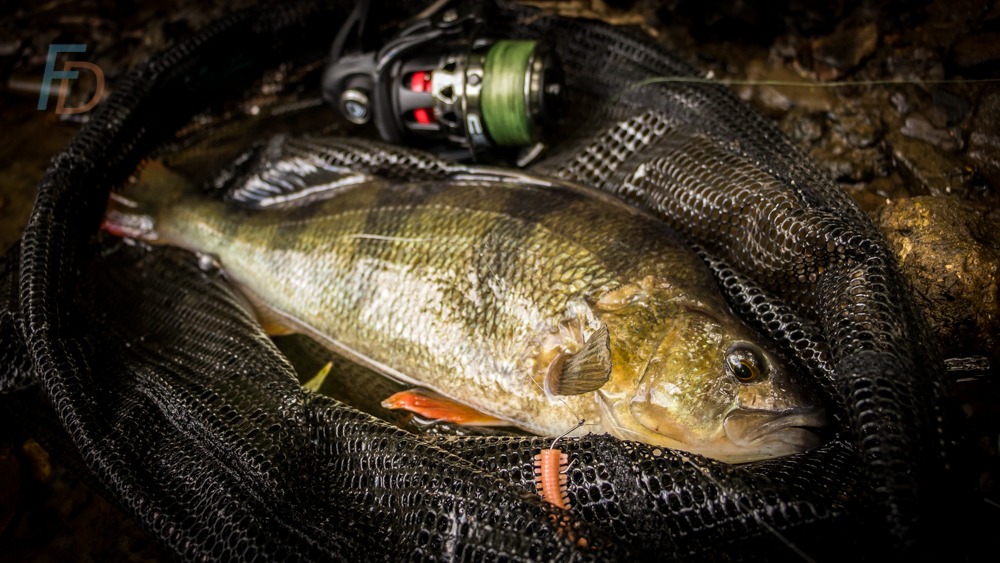
Drop Shot Rig for Perch
Aside from down-sizing the hook a bit compared to bass, a drop shot rig for perch can be identical to the original versions for largemouth bass. You just need to account for the smaller mouth of a perch!
The key components are a weight attached at the end of your line (although I’ll cover some clever modern tweaks later in this article…) and a hook attached to your line using a special knot to make it fish “point-up” and perpendicular to your line. Here's how to tie that knot:
For ultimate bite-detection, braided main-line (with its near-zero stretch) is a good choice. A “leader” of fluorocarbon to present your hook and attach your weight completes the basic rig.
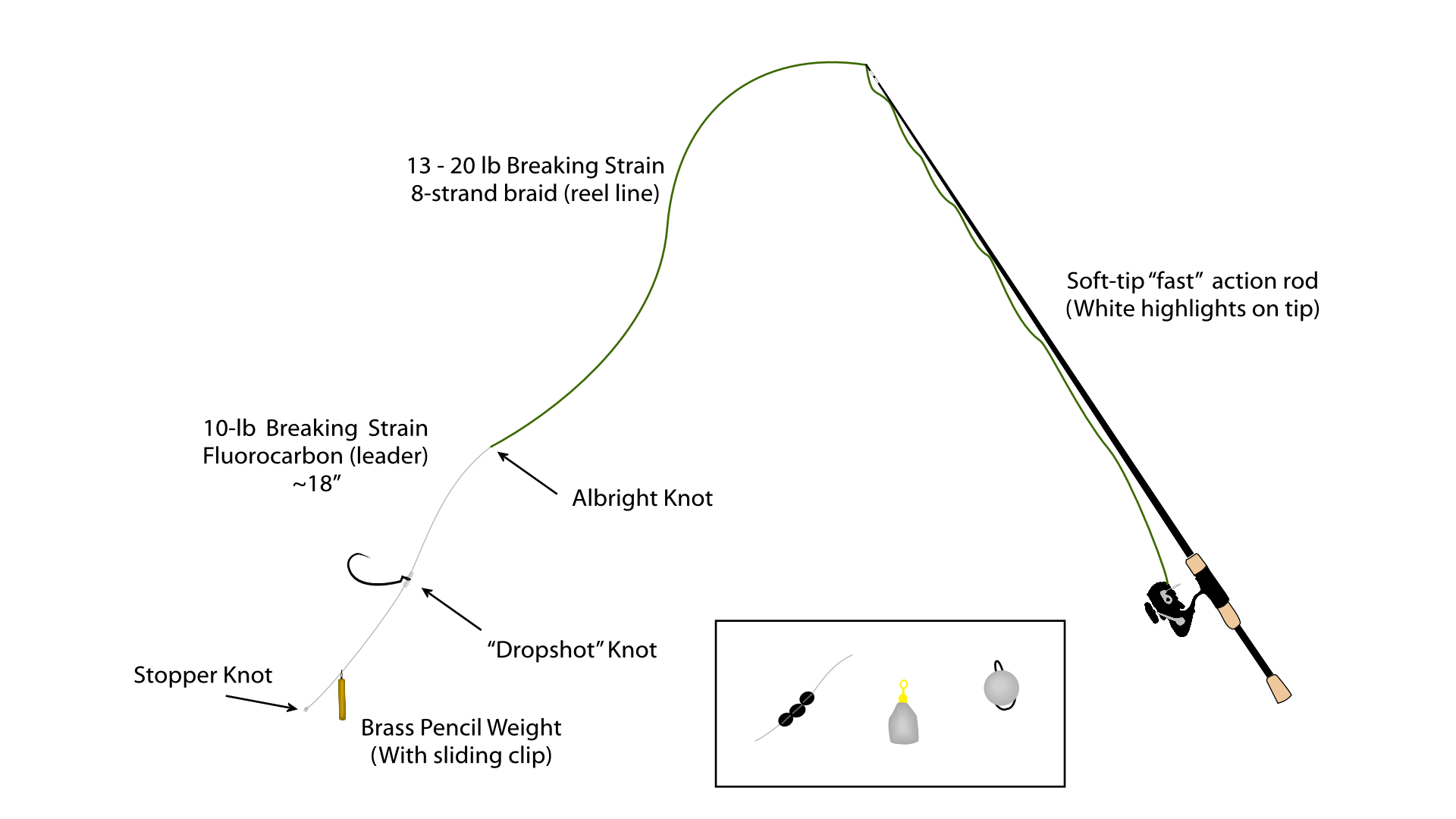
Drop Shot Rig for Perch: Basic Options
Depending on snags, braid in the 13lb – 20lb breaking strain range will see you right. I like a three-foot fluorocarbon trace (usually 10lb breaking strain) attached with an Albright knot to the braid.
Dropshotting for Perch: Reels
When dropshotting for perch, I prefer a fixed-spool reel. As well as being able to cast lighter weights easily over greater range, having a rig that separates the weight from the lure is an important factor:
Managing the separation between casting-weight and lure is a little easier with a fixed spool reel due to the lower emphasis on loading the rod compared to bait casting reels.
With a fixed spool, there's less benefit in reeling the casting weight/lure right up tight to the rod-tip.
Reels can be as small as 1000 size and up to around 2500 size (as pictured below) to match the sweet spot in casting weight/bait-sizes for perch.
Dropshotting for Perch: Rods
A rod with a soft, sensitive tip and more backbone further into the blank is ideal for detecting subtle strikes on your lure, while still getting a good hook-set.

You can buy purpose-designed drop-shotting rods (the upper rod pictured above) – and these can actually make good finesse lure rods when fishing other soft plastic rigs too. That can be important to know when your budget is tight. With that said, you can still fish a drop shot from other styles of light lure rods as well.
It is just that, if you're only going to buy one rod for both light lure fishing AND drop shotting for perch - a drop shot rod is probably the most adaptable.
Weight options (See Highlighted Box in Rig Diagram Above)
The first thing to emphasise is that split shot still work! Basically, at a pinch, you ought to be able to scratch around in your kit and find something that will do the job.
Small pear-shaped weights/sinkers with swivel attached (in the 1/8th oz/3.5 g range) were early favourites with bass anglers. Nowadays there are many custom-made drop shot “pencil” weights with line-clips that allow you to move the weight up and down the line to change the fishing depth. That ability to fine-tune the fishing depth really improves your chances of success when dropshotting for perch.
Be careful though – at the very least you need to tie a knot in the end of your leader to help pull those moveable weights clear of snags (otherwise they just slide off the end of your line).
I actually find that the clip design often cuts your line far too easily (and pulling the line through the clip when you do get snagged “pigtails” the fluorocarbon).
Again, this is another example of the Fishing Discoveries philosophy of cross-pollination between different branches of fishing - so as well as the drop-shotting tactics covered in the section below, you could take back some of the advantages normally guarded by top lure anglers:
"Unfair Advantage" Lure Fishing Tactics...
I've pulled together some of my favourite "unfair advantage" knowledge and turned it into a free e-book as a subscriber bonus. It needed a catchy title - so the idea of downloading this and then being able to switch into "Fishing-god Mode" at any time made me smile...
Just Click Here or on the Book Image/Button below to register for your Free Copy - plus 5 more fishing secrets via email:
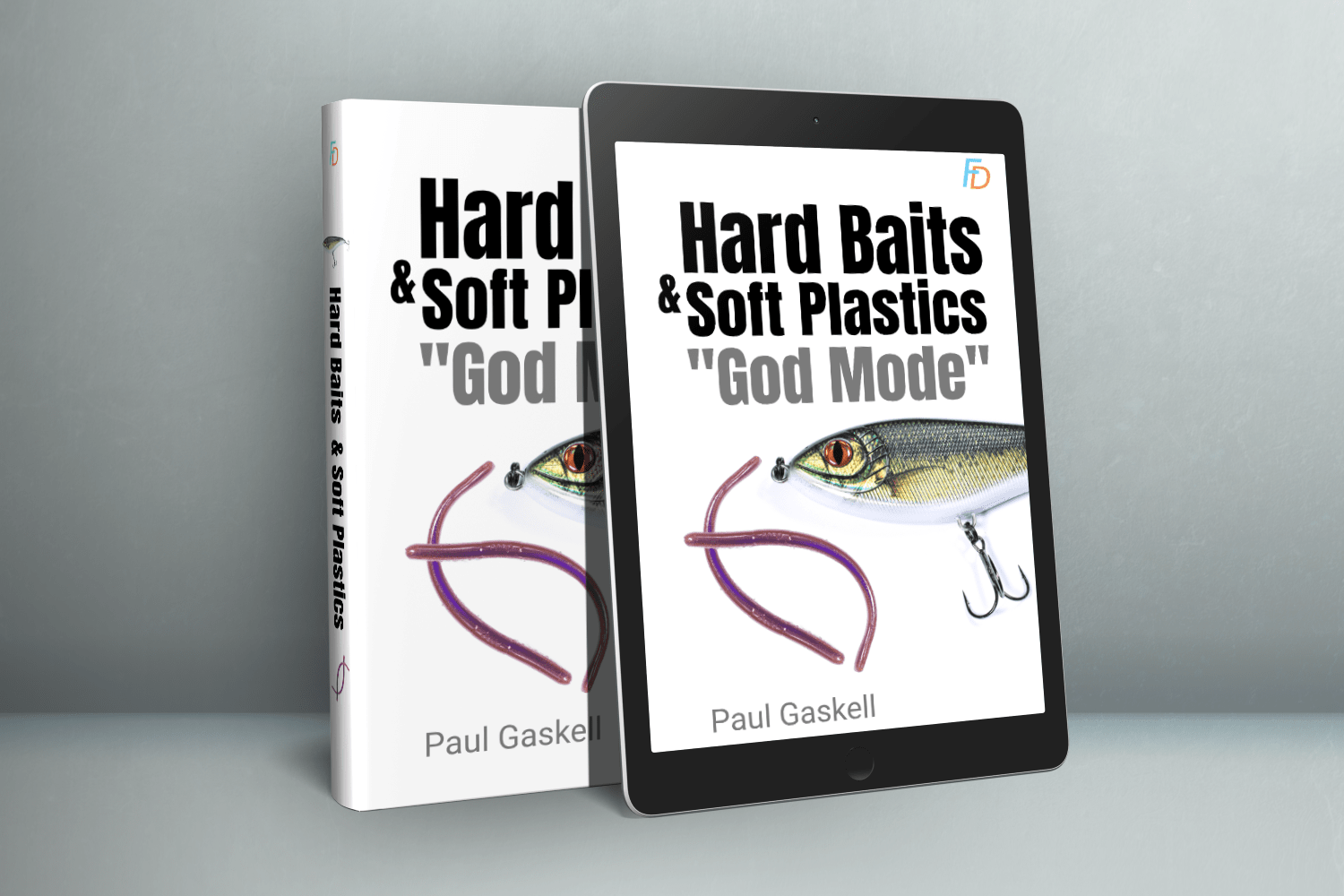
Dropshotting for Perch: Presentation Tactics
A major advantage to the drop shot rig is the degree of control over the depth of your lure – regardless of the pace that you fish it. On pressured waters (or days when fish are not aggressive), fishing jigs can be less effective. With a perch jig setup, everything generally moves quite quickly (one reason it is good for searching water).

Perch caught while covering water and searching with a jig
That quick movement can either be the pace you need to retrieve to keep your lure off a really snaggy riverbed – or simply because of the natural sink-rate of the lure in freefall.
In other words, even when you land the jig on the bottom and “hop” it along, the rise and fall movements of the lure have a certain minimum speed – and that minimum is still fairly fast. When fish are unwilling to chase or strike at fleeing prey, that presentation style isn’t your best bet.
Drop shotting gives you a couple of great alternative presentation “modes”
Semi Static Mode: “Deadsticking”
This is where you cast your lure out to a feature or chosen spot and allow the weight to settle on the bottom. Gently reeling down so that you can feel a light tension between your rod tip and the weight allows you to hold the lure at a particular depth (depending on the angle of your rod tip, as long as you are not fishing directly above your rig – from a boat or platform).
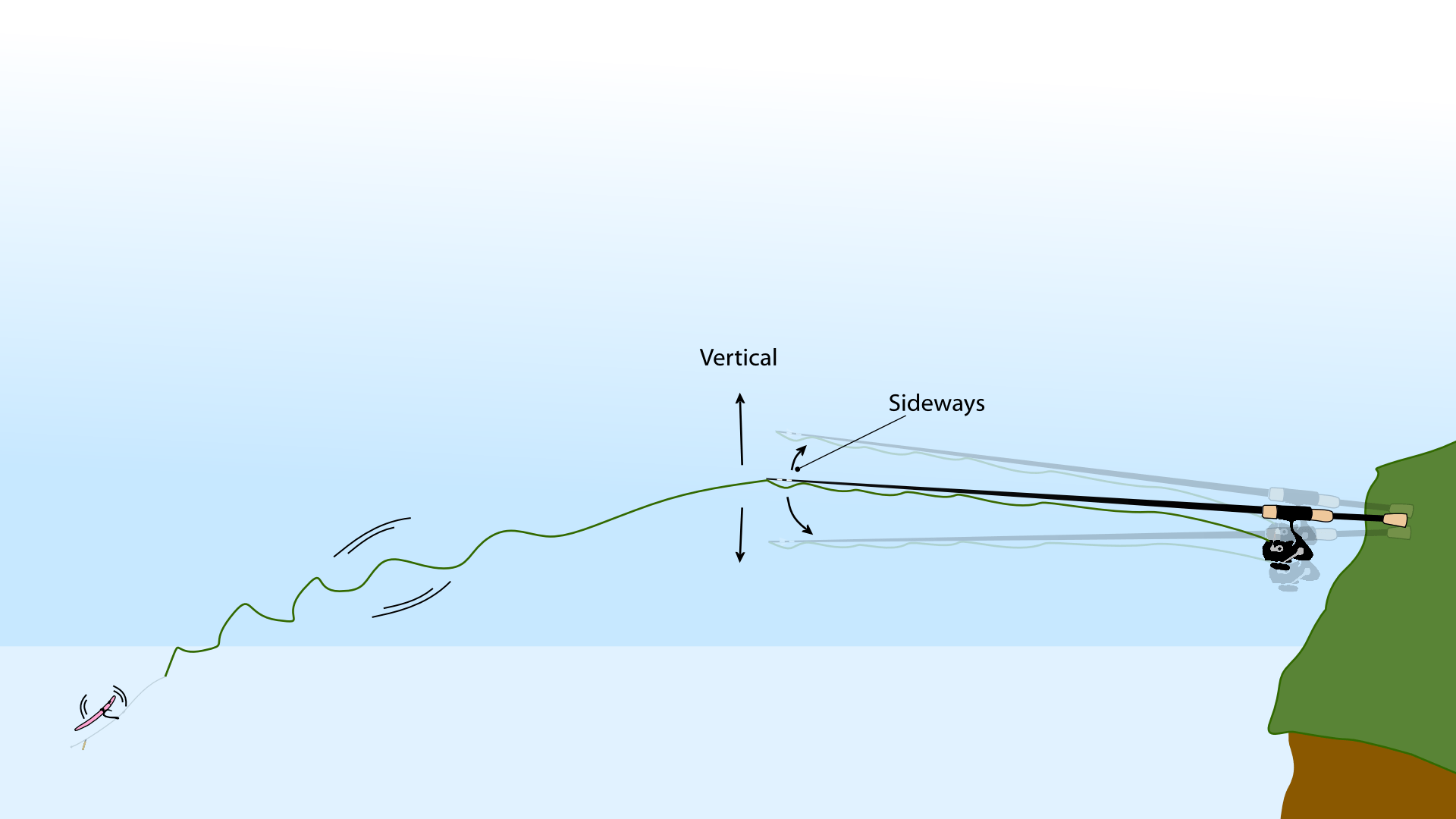
The deadsticking tactic (pictured above) is where you gently waggle your rod (often side to side or sometimes up and down) so that the lure wriggles attractively on the spot. If you make the movements small enough, the weight should stay where it is while the lure wriggles and jerks.
Of course, if you feel or see any tremble or nibble through the rod tip, you need to set the hook.
Remember to experiment with how often and how vigorously you wriggle your lure.
The colder the weather, the more static (and closer to the bottom) your presentation can be. Occasional, small wriggles can work really well. In warmer weather, you can work the lure more aggressively over longer durations (but still include short pauses to imitate the death throes of prey).
The sudden stop in movement can make a fish more curious – with the next wriggle causing it to make its mind up and strike the lure.
Subtle Search Mode: “Crawling” while dropshotting for perch
On popular venues both jig fishing and deadsticking with drop shot rigs can sometimes be treated with more suspicion by fish. In fact, on any water, an essential tactic to try is an ultra-slow “crawl” – mixed in with gentle deadsticking-style rod movements.
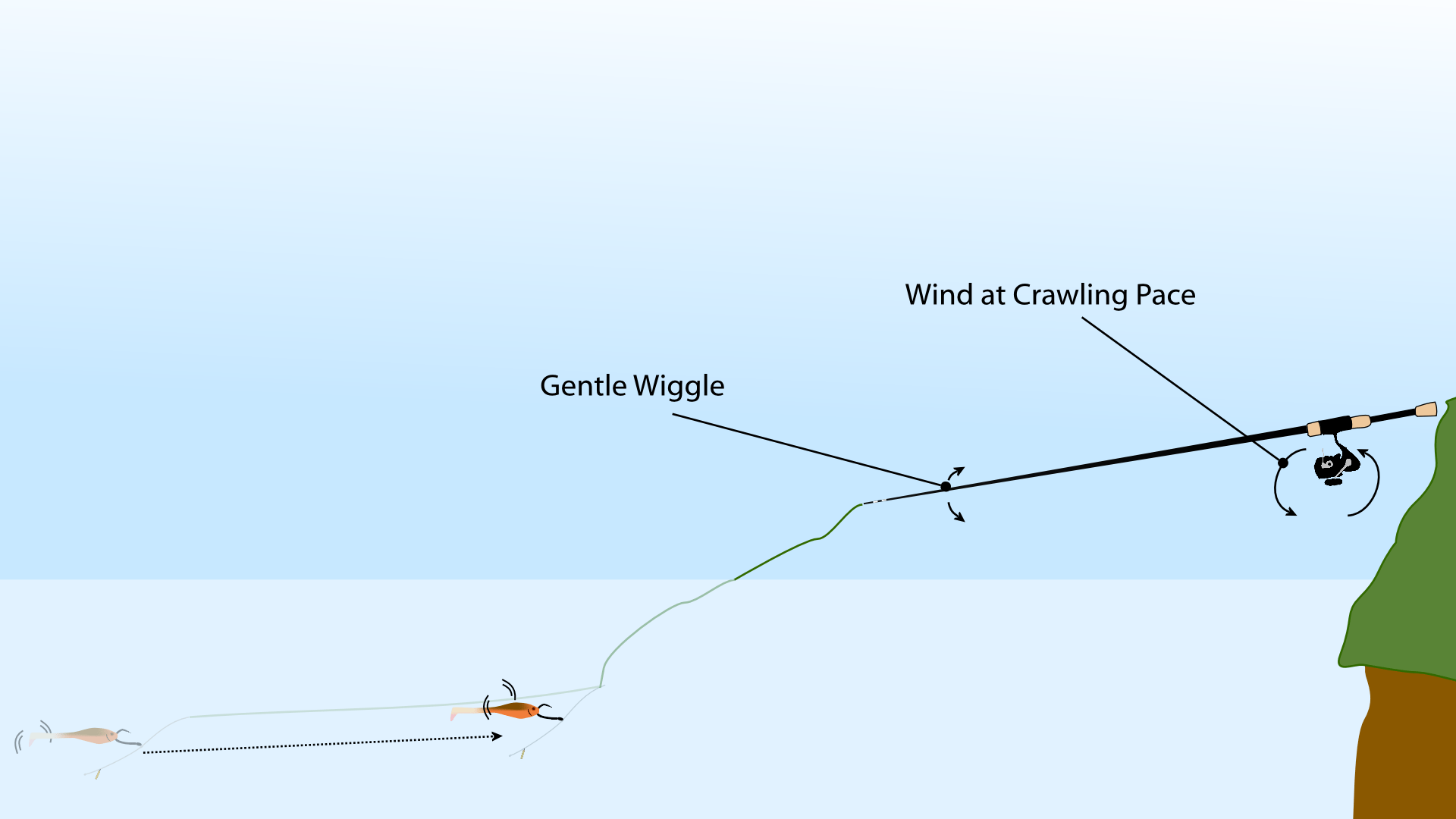
Many anglers don’t view dropshotting as a search method. Instead they look to search with jigs and then, when fish are found (through follows or tail-nips), switching to a drop shot approach to try for a capture.
Don’t forget that you can search while dropshotting! It might not be as rapid-fire as jigging (although it can be if necessary), when it comes to catching fish, the ultra-slow turns of the reel which barely keep the weight crawling towards you along the bed can be hard to beat.
Even though the movement is (often) slow and steady, it still allows you to carve the water up into a series of “transects”. This is very different from casting out and only dead sticking in one spot.
With static deadsticking, the zone you are covering is very small on each cast (which is what you’d want if you’ve precisely nailed down the location of fish you’re targeting).
Again, experimenting to find the right intensity and frequency of rod-tip manipulation is key to this method. The slow crawl with the right manipulation is what gives experienced lure anglers a real edge when drop shot fishing for perch on hard-fished canals, rivers and lakes.
Drop shot fishing for perch: Lure choices
Obviously you can buy a variety of soft plastics labelled as “drop shot lures” – and you won’t go far wrong with these. They are often available either pre-rigged or as part of a kit with weights, leader and rig-holder spools. Most often, you’ll find these are paddle-tail lures with a nice inherent action when lifted and allowed to drop.
Don’t forget though that any soft plastic can be presented while dropshotting for perch. Whether we're talking flukes, grub-tails, paddle-tails/shad-style lures or the various worms – they can all be highly effective.
Just pay attention to how you hook each of these lure styles to get the best out of them.
Here’s a few examples to get you thinking along productive lines…
Small "shad"/paddle-tails and flukes
Best hooked at the front of the head – but experiment with the orientation. In other words, try hooking so that the lure swims in an upright plane (hook-point in through the bottom lip and out through the top of the head).
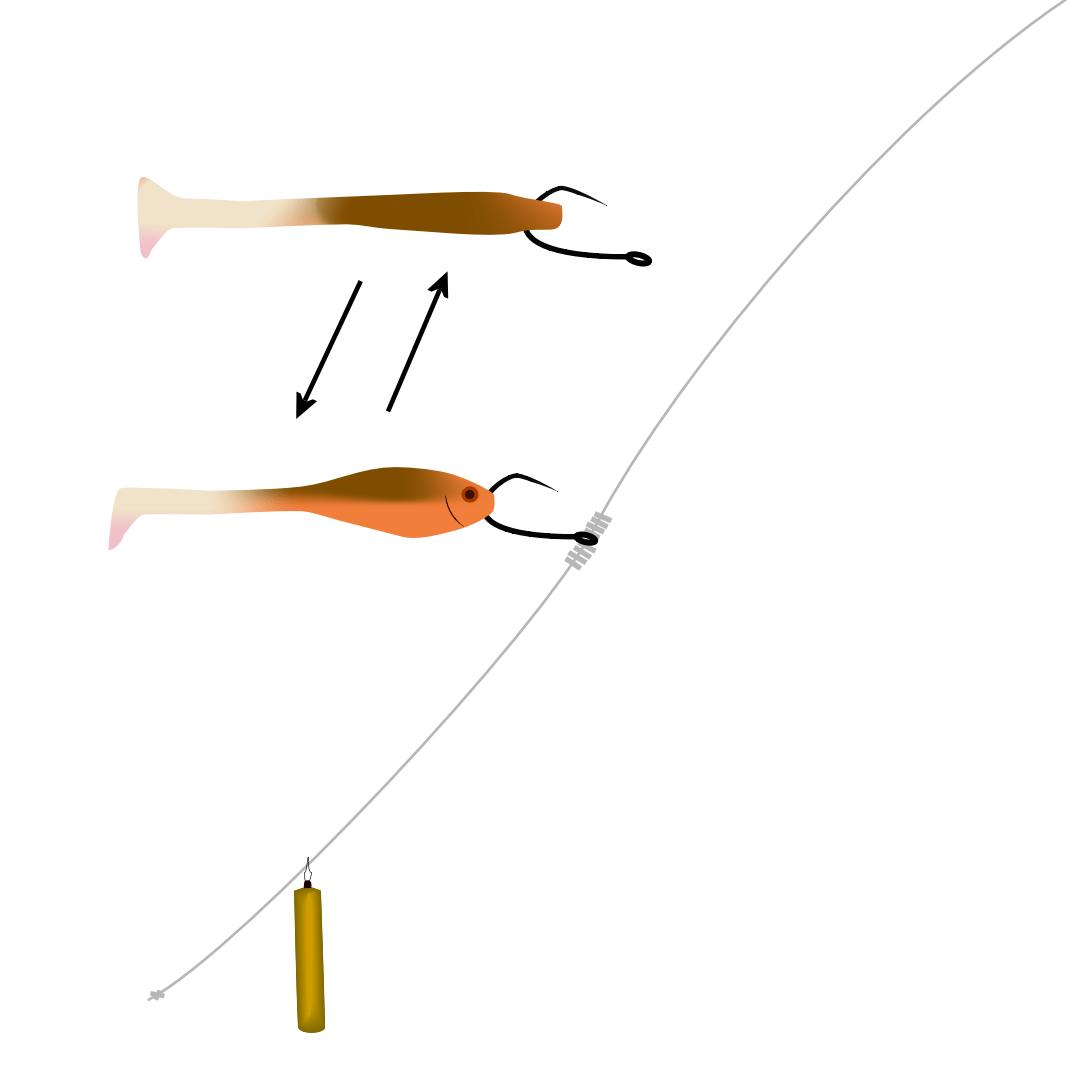
"Micro Fry" style lure - with options to hook sideways (top) or in a standard vertical plane (bottom). Note the custom-designed sliding brass pencil weight for drop shotting
As an alternative, hooking the same lure through the side of the head can give an extra “wounded prey” effect.
Plastic Worms
This is a really wide-ranging category with everything from fat Senko style worms, through straight worms (like the roboworm) and even small 2” sandworms. Because of that wide range of styles, there are a lot of options for rigging them on the hook - as we'll see below.
Perhaps it shouldn’t need repeating but, just in case, Perch Love Worms. I think a lot of anglers get a bit too hung up on the fish-imitating drop shot lures and can ignore artificial worm options. So, treating them like the a truly generalist predator is important.
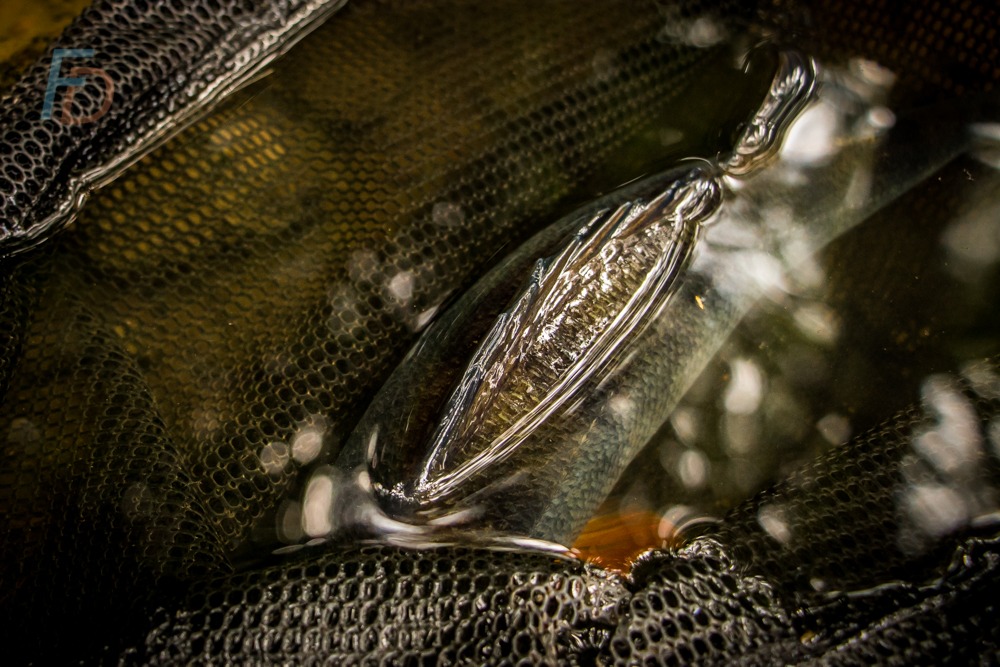
Here’s a few suggestions to kick start your own experiments in bait style and hooking/rigging
Oxblood/red flake Roboworm (straight tail)
Available in a range of lengths – 4.5” is a good one for UK perch. My favourite option for these is to rig them weedless on an offset worm hook – just as you would for a Texas rig (full on bass style).

"Texas-rigged" Roboworm - a great bass and perch bait
Roboworms can also be good rigged “wacky rig” style on a smaller hook. See the next option for more information.
Senko/Stick worms
If you have big perch in your waters, then a nice fat mouthful can be a good way forward. Although not the only way to rig them (and in fact, these are great fished with no additional weight), wacky rigging using a flexible O-ring is definitely worth a try on a dropshot setup. They are also good simply free-lined in stillwater venues.
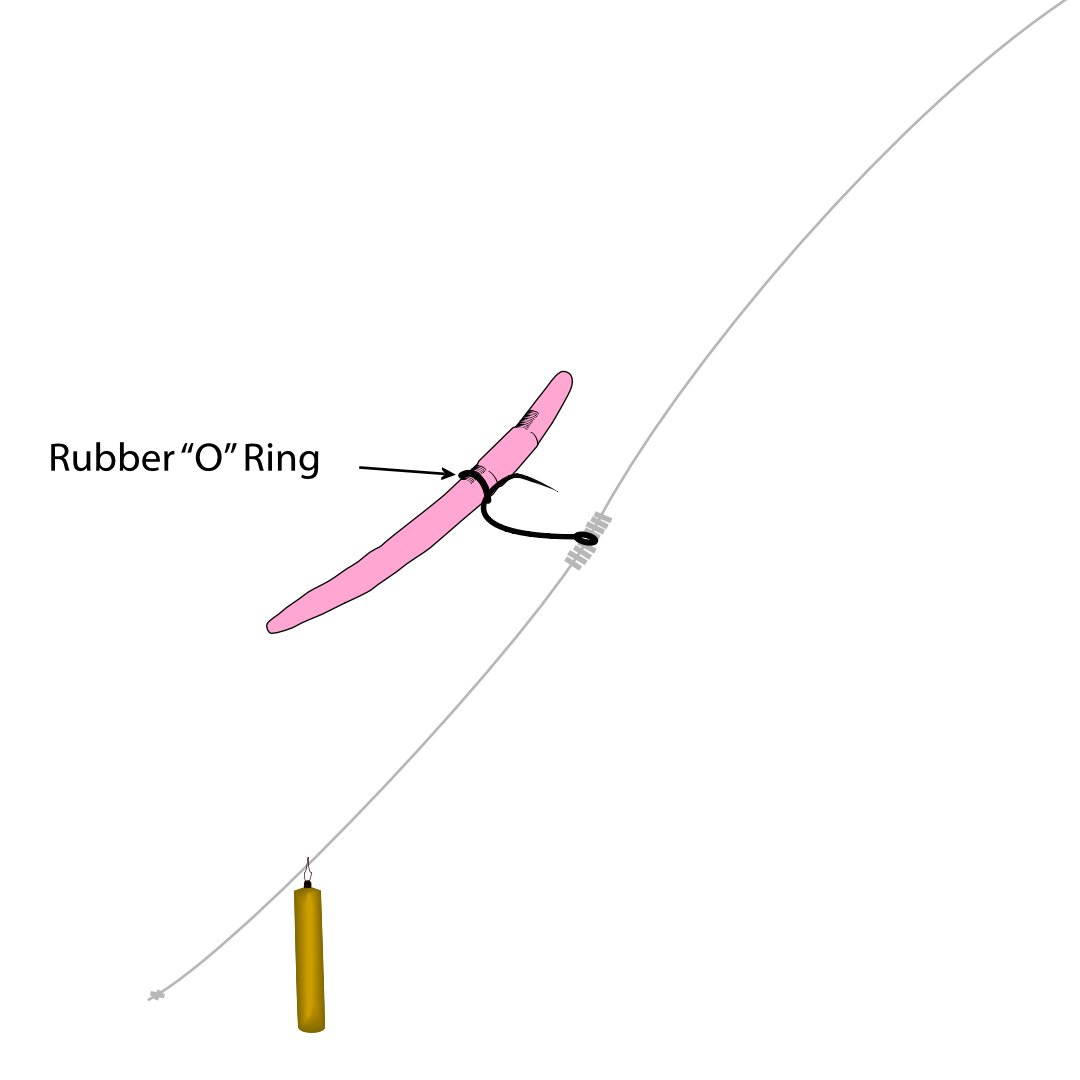
"Wacky-rigged" Senko worm: Big fish bait!
By positioning the O-ring exactly in the middle, the bait will sink and hold in the water on a horizontal plane (it also stops your bait getting torn up by the hook). Any dead-sticking rod tip manipulation causes the worm to wriggle from the middle – with both head and tail ends kicking violently.
Sandworm (with flavour)
Berkley Gulp sandworms are available in a range of sizes – and for perch I like the 2” ones. The lovely perch in the photo at the top of this article took a fancy to one of these (you can see it in the net - along with the drop shot rig).
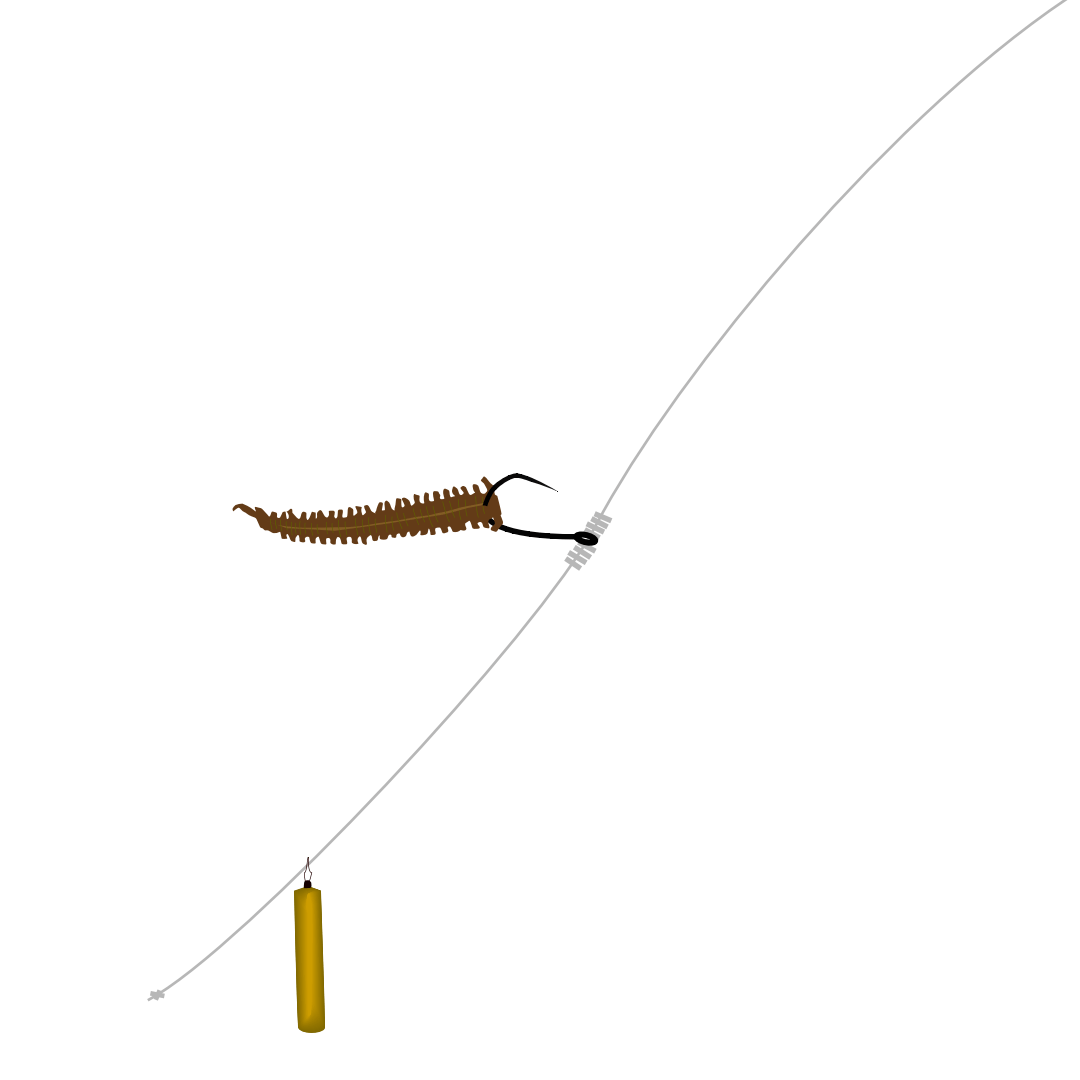
Berkley Gulp Sandworm (2") - A very versatile drop shotting bait
They are a great option for coloured water because they are strongly scented – to help fish track them down (and hold onto them once they’ve slurped one into their mouth). For these, I like a simple hooking at the head end so that the flattened side fishes parallel to the river bed.
Dropshotting for Perch: Round-up
Remember that the lure suggestions included here are really just the tip of the iceberg. When trying out your own options, think carefully about which of the rigging styles will function best for that lure - AND the situation you're fishing it in.
For example, in snaggy waters, the Texas rig style of hooking your soft plastic will be important. If only the action of your bait is important, think how best to hook it to create the most "wriggle" - even with small, gentle movements of the rod tip.
As well as being able to twitch your bait on the spot, don't forget the crawling/subtle searching approach. In fact, it is perfectly possible to fish a drop shot rig with a very similar retrieve to any that you would use with a jig. That can be a great tactic which allows you to "hop" a bait really close to the bottom - but with less chance of snagging up on rocks compared to a weighted jig.
I hope there is plenty here to fuel your own successful experiments while dropshotting for perch.
Paul
PLEASE LET ME KNOW IN THE COMMENTS WHAT YOU LIKED - OR WHAT YOU THINK I MISSED...and do hit the social share buttons to send it on to friends who might benefit from this stuff.

What are the pros and cons of using a drop shotting hook with the top and bottom swivel versus directly tying a hook to your line
With swivels it can be easier to rig up a bite-proof trace where you may get some accidental pike captures. You do lose some finesse in the presentation with the weight/bulk of the swivels and, in clear water using small baits that natural movement can be an important factor in getting as many hits as possible.
Hope this helps!
Paul
Rather than using a knot to tie leader to mainline, could you use a snap swivel (or those lightweight rig connectors – Carlussi?)? That way, if you want to change from dropshot rig to a lure, it’s an easy switch.
Yeah, it’s possible. It all really depends on how much “drop” you’re comfortable with casting (with a knot connection to braid at the butt end of a leader – it can pass through the guides on your rod and allow you to reel up much closer to the hook before casting either rig).
Hope that helps and thank you for the suggestion,
Paul
Thanks Paul,
I’m just getting into this style of fishing. I’ve found this article very interesting and informative.
Looking forward to reading your ebook,for more ideas.
Dave
Cheers Dave, that’s very kind feedback and I hope you’ve continued to find some useful tips and content in the e-book (and elsewhere on the site).
Paul
I’m a new subscriber from Minnesota in the United States and I want to take the time to thank you Paul for writing such a great article complete with the rigging diagram which is a gem. I fish primarily for smallmouth bass, but it’s an inevitability in our Minnesota and Wisconsin (I’m fortunate enough to have a lakeside cabin in northwestern Wisconsin) waters that we catch “incidental” fish species while bass fishing.
On the large side of the incidental catch scale are pike and muskie which are native to this part of the world and are absolutely beasts to catch on non-muskie gear! On the small side of the fish list, we are fortunate enough to have a wide diversity of bluegill, crappie, perch (not as monstrous as your perch in UK/Europe), and white bass to name a few.
My introduction to ultralight lure fishing for perch occurred while dropshotting for smallmouth bass (we do a lot of that in the summertime) a few years ago using a #4 Owner Mosquito hook and a 1/32oz Ryugi Tungsten Ringed Delta Sinker. My fishing buddy and I found an absolutely massive school of perch and juvenile walleye (cousins of the Zander), and we sat on that school for over 90-minutes and managed to catch 192 fish of both species (we only catch and release)!
Since that trip I’ve heavily invested in premium JDM LRF/Aji fishing tackle and last year I got a new cabin lake boat with Lowrance Active Target forward facing sonar, and it’s vastly improved our ability to find fish and learn about how they react to our lures, an array of sonar pings (the new boat has four different sonar transducers for Down Scan, Side Scan, Mega 360, and Active Target), and general boat movement/noise!
I know that in the US we are very fortunate to be able to fish from a multitude of public bodies of water with boat launches and I agree that your philosophy of cross-pollination of fishing ideas and techniques works fantastically. I’m eager to learn more about how the fishing in the UK and Europe can be adapted to our fishing in the US. Conversely, we can share our experiences fishing in the lakes and reservoirs of the “Northwoods” with you as well Paul!
Thanks again for the great article and I look forward to learning more about everything related to BFS fishing!
Thank you so much for a fantastic response NV – I really appreciate it and it’s great to know that our philosophy of cross-pollination is something you share too!
Paul
Hi Paul, please tell me you have tried dropshotting for Grayling with your Marryat Tactical 10’6” #3; ladder leader with “wormy” soft plastic on the point, then conventional nymph flies on the dropper(s) 😊
I haven’t yet Andrew, but never say never ha ha ha.
What I have recently been doing is fishing for grayling using ultra (ultra) light jigs on little hooks and BFS gear…
Paul
Great reading!
Thanks for sharing!
Cheers Mait – much appreciated.
Paul
Hi, You noted strong scent on lures!
I haven’t heard, that perch would sniff smell or tasting these?
I’ve always thought for perch, it is the vibration and based on water transparency (clear, muddy, etc.) the color of lure?
Can you explain smell and colors on soft bait lures more out in details?
Many thanks for great articles and for helping with an explanation!
Cheers from Estonia and Finland sides! 🙂
Hi there – it’s common in the UK to catch perch (of various sizes) when fishing with a variety of living baits (from worms to maggots) that are often thrown in as loose feed and to which scented attractants may also be added. It seems reasonable that, like many other fish, their ability to detect and home in on scent in the water will sometimes be important to their hunting behaviour.
Also, another common factor in largemouth bass fishing around the world is the use of salt and other flavourings on soft plastic baits as a way to encourage fish to hang on long enough to get a good hook-set. So it may or may not be important in the fish finding those baits in the first place (that might be primarily visual or vibration); but once they take hold, having a flavouring could just buy you a little bit of time to get that good hook-set. I see no reason why this wouldn’t also operate in perch fishing.
Hope this is helpful!
All the best,
Paul
This system similar to old school nymphing in fly fishing, they put lead/weight instead of heavy/weighted point fly in order to have some degree of line tension, easy casting and reduce bottom snag. Have you guys tried it in stream (flowing water) with subsurface flies instead of soft plastic for trouts and graylings?. I’m still learning about spin fly fishing which is using spinning rod and reels to deliver small flies (kebari, nymph, caddies, ext) to fish. Unfortunately we don’t have trout and grayling in our fisheries. I’m sure with all your expertise and experience in Tenkara and fly fishing, you have many great inputs and suggestion for us about this way (spin fly)of fishing. Thank you very much in advance.
Hi Widy, it is interesting that you mention that similarity to some nymph fishing techniques. There is quite a lot of detail about a “Slovakian nymphing” style of fishing in the Fly Fishing Bible of Nymphing where I flag up the comparison to drop shotting. However, there are differences as well – as one of the main aims of the Slovakian rig is to overcome extremely fast flowing water.
My best wishes as always,
Paul
Thank you for your writing about slovenian system in nymphing hand book is very clear and i learned a lot from it. We’re using the same delivery system for throwing tiny soft plastic lures, micro streamers, wet flies, nymphs, kebaris ect. With spinning or BFS tackles and very thin high visible braid or polyester as main lines (0.06 to 0.3 Gou – Japanese size), we can get a very good distance and don’t have to worry about line mending while maintaining that DT’s triangle of awesome.
Great Article Paul. Not only this one but the other articles as well. Keep writing ease 😊
Thanks so much Luke – it’s really kind of you to let me know that you’ve been enjoying the content I’m working on.
There’s more coming soon (I just need to get on top of the nymph fishing book I’m writing at the moment!!)
Paul
Good article.
For the braid to mono connection though the FG knot is hard to beat.
Good call – I’ve looked at a few different ways of tying it and I think I’ll do some experiments with the FG.
Thanks for the kind comment too.
Paul
Great read keep them coming 👍🏻👍🏻👍🏻👍🏻
Thank you Jack – that’s really kind of you to say.
I’m working on some perch stuff (just drawing diagrams this evening actually)…
Paul